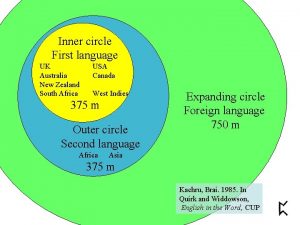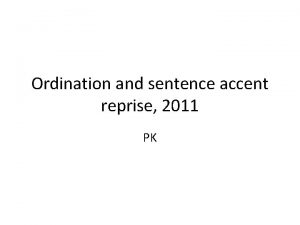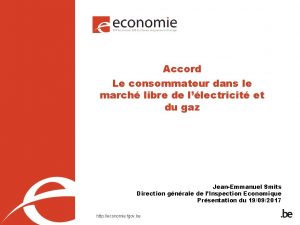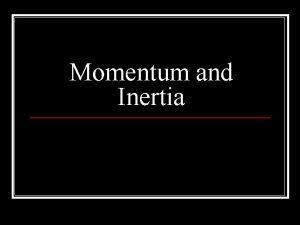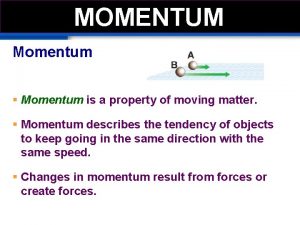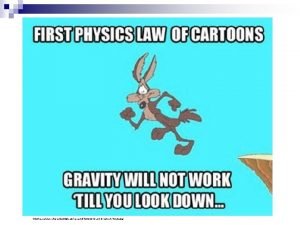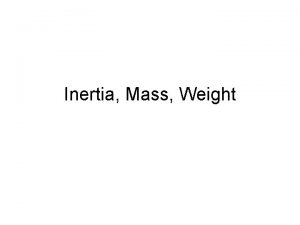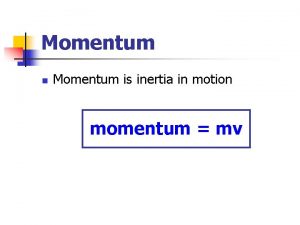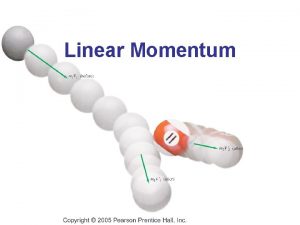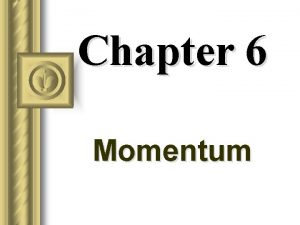Dynamics Cause of Motion Reprise Inertia Momentum Newtons












- Slides: 12

Dynamics: Cause of Motion

Reprise: Inertia & Momentum • Newton’s First Law – Law of Inertia (2 parts) • Momentum, p, is a vector quantity associated with both mass (arbitrarily defined) & velocity. • p = mv (units typically kg*m/s) • The momentum of an object at rest is 0. • Inertia should not be confused with momentum; inertia is a body’s tendency to resist changes in motion; non-mathematical.

Total Momentum is Conserved • Momentum before = momentum after (pi = pf) – Holds in explosions, collisions, and some +/- of mass – Does not hold for falling bodies UNLESS Earth’s momentum is taken into account • Examples of momentum conservation: – Recoil of a rifle or handgun. – Dropping mass on a moving cart. – Ice skaters pushing off one another. – Astronaut pushing off a space ship. – Rocket in flight.

Conservation of Momentum • Demonstration: the total momentum of an isolated system is conserved. That is, pi = pf if and only if we have an “isolated system” – no unbalanced outside forces. • Example 1 – the collision of carts • Example 2 – the “explosion” of carts • Example problems…

Example Problem 1 • A truck with a mass of 3, 000 kg and a velocity of +20 m/s collides head on with a car of 1, 500 kg mass and a velocity of -20 m/s. If the vehicles stick together, what is the resulting motion of the pair? • Solve using conservation of momentum; that is, pi = pf.

Example Problem 2 • A train car (mass 11, 200 kg) is moving along at a speed of +2 m/s. A 5, 000 kg mass of coal with no horizontal motion is dropped into the hopper of the train car. What is the resulting motion of the train car now loaded with coal?

The Second Law of Motion • a. k. a. Newton’s Second Law • The net instantaneous force acting on an object is precisely the instantaneous change of its momentum per unit time. In symbols, the second law can be written as F = Δp/Δt with Δt very small. • Note that F and Δp are vectors.

Newton’s Second Law • Experience: – Acceleration as a function of force (constant mass system) – Acceleration as a function of mass (constant force system) • Demonstration: – a is proportional to F – a is inversely proportional to m • Conclusion: F = kma; k = 1 if F is defined properly. • F is defined in terms of a newton, N = kg*m/s 2 – 1 N is the weight of a small apple approximately (~3. 60 oz. )

Second Law Reprise F = Δp/Δt F = Δmv/Δt F = mΔv/Δt (constant mass system, no rockets!) F = ma as well as FΔt = mΔv (impulse-momentum) F, v, and a are all vectors; m is a scalar. The sum of forces acting on a body produce an acceleration inversely proportional to mass. • ΣF=ma (where F is expressed in Newtons) • • •

2 nd Law Problem – Examples • An car with a mass of 1, 500 kg accelerates at a rate of -2 m/s 2 under a constant force. What are the magnitude and direction of that force? • How much force would it take to slow a 75 kg person riding in a car going +20 m/s to a complete stop if the time was 0. 03 seconds – the typical time of an auto collision?

More Examples of Newton’s 2 nd Law • An object accelerates at a rate of 1. 5 m/s 2 under a force of 53 N. What is its mass? • How much upward force does the ground apply to someone with a mass of 75 kg to counter balance the pull of gravity? Note that g = -9. 8 m/s 2 and that Fnet = ma and that a = g. • In short, W = mg

Newton’s Third Law • If object A exerts a force FAB on an object B, then object B exerts a force FBA on object A such that FAB = -FBA. • If an object is not accelerating, then FAB = -FBA and the sum of forces (vectors) equals zero. • An object can accelerate only if the vector sum of forces acting on it does not equal zero. • If Newton’s third law is correct, how is it possible to for anyone to win a tug-of-war?
